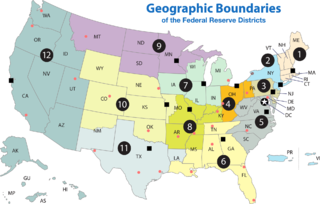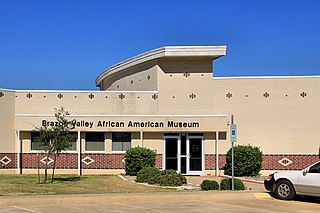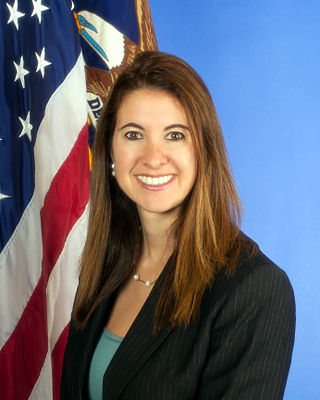
A Federal Reserve Bank is a regional bank of the Federal Reserve System, the central banking system of the United States. There are twelve in total, one for each of the twelve Federal Reserve Districts that were created by the Federal Reserve Act of 1913. The banks are jointly responsible for implementing the monetary policy set forth by the Federal Open Market Committee, and are divided as follows:

The Bracero Programs were the result of a series of laws and diplomatic agreements, initiated on August 4, 1942, when the United States signed the Mexican Farm Labor Agreement with Mexico. For these farmworkers, the agreement guaranteed decent living conditions and a minimum wage of 30 cents an hour, as well as protections from forced military service, and guaranteed that a part of wages was to be put into a private savings account in Mexico; it also allowed the importation of contract laborers from Guam as a temporary measure during the early phases of World War II.

Immigration is the international movement of people to a destination country of which they are not natives or where they do not possess citizenship in order to settle as permanent residents or naturalized citizens. Commuters, tourists, and other short-term stays in a destination country do not fall under the definition of immigration or migration; seasonal labour immigration is sometimes included, however.

Foreign nationals (aliens) can violate US immigration laws by entering the United States unlawfully or lawfully entering but then remaining after the expiration of their visas, parole, TPS, etc. Illegal immigration has been a matter of intense debate in the United States since the 1980s.
Anita Arrow Summers is an American educator of public policy, management, real estate and education and is Professor Emerita at the University of Pennsylvania.
George Jesus Borjas is a Cuban-American economist and the Robert W. Scrivner Professor of Economics and Social Policy at the Harvard Kennedy School. He has been described as "America’s leading immigration economist" and "the leading sceptic of immigration among economists". Borjas has published a number of studies that conclude that low-skilled immigration adversely affects low-skilled natives, a proposition that is debated among economists.
The American Society of Hispanic Economists (ASHE) is a professional association of economists in the United States that promotes the representation of Hispanic Americans within the economics profession and supports economic research relevant to Hispanic Americans. ASHE is recognized by the American Economic Association as one of the academic organizations comprising the Allied Social Sciencs Associations.
The economic impact of undocumented immigrants in the United States is challenging to measure, and politically contentious. Research shows that undocumented immigrants increase the size of the U.S. economy/contribute to economic growth, enhance the welfare of natives, contribute more in tax revenue than they collect, reduce American firms' incentives to offshore jobs and import foreign-produced goods, and benefit consumers by reducing the prices of goods and services.

African American Texans or Black Texans are residents of the state of Texas who are of African ancestry and people that have origins as African-American slaves. African Americans formed a unique ethnic identity in Texas while facing the problems of societal and institutional discrimination as well as colorism for many years. The first person of African heritage to arrive in Texas was Estevanico, who came to Texas in 1528.

Adriana Debora Kugler is an American economist who serves as a member of the Federal Reserve Board of Governors. She previously served as U.S. executive director at the World Bank, nominated by President Joe Biden and confirmed by the U.S. Senate in April 2022. She is a professor of public policy at Georgetown University's McCourt School of Public Policy and is currently on leave from her tenured position at Georgetown. She served as the Chief Economist to U.S. Labor Secretary Hilda L. Solis from September 6, 2011 to January 4, 2013.

The University of Texas Rio Grande Valley (UTRGV) is a public research university with multiple campus throughout the Rio Grande Valley region of Texas and is the southernmost member of the University of Texas System. The University of Texas Rio Grande Valley (UTRGV) was created by the Texas Legislature in 2013 after the consolidation of the University of Texas at Brownsville/Texas Southmost College and the University of Texas–Pan American.
Havidán Rodríguez is an American sociologist and university administrator. He is currently the president of the University at Albany, SUNY. He earned his Ph.D. in sociology from the University of Wisconsin–Madison.
Currently, there are over 20 million immigrant women residing in the United States. The American Immigration Council states that the majority of these immigrant women come from Mexico, meaning that the main demographic of immigrant women in the U.S. are Latina. As the fastest growing minority group in America, Latinas are becoming primary influencers in education, economics and culture in American society and the consumer marketplace.
William R. Kerr is the Dimitri V. D'Arbeloff – MBA Class of 1955 Professor of Business Administration professor at Harvard Business School, where he is a co-director of Harvard's Managing the Future of Work project and faculty chair of the Launching New Ventures program for executive education.
Ethan Lewis is a labor economist and Associate Professor of Economics at Dartmouth College. His fields of specialization are labor economics and econometrics with a specific interest in how U.S. labor markets have adapted to immigration and technological change.

Susan M. Collins is an American economist who has served as the 14th president and CEO of the Federal Reserve Bank of Boston since July 1, 2022. She is the first African American woman and first woman of color to lead any of the 12 regional Federal Reserve Banks. Collins previously served as the 16th provost and executive vice president for academic affairs of the University of Michigan from 2020 to 2022.

Philip Nathan Jefferson is an American economist who serves as vice chair of the Federal Reserve. He has been a member of the Federal Reserve Board of Governors since 2022. He was nominated for the position by President Joe Biden in January 2022, and was confirmed by the Senate in May 2022. Upon taking office, he became the fourth Black man to serve on the board.
Catalina Amuedo-Dorantes is a Spanish economist, a Professor in the Economics and Business Management faculty at the University of California, Merced and a Professor and Department Chair at San Diego State University. Since 2015, she has been the Western Representative for a standing committee called the Committee for the Status of Women in the Economics Profession (CSWEP). Her field of work focuses on the fundamentals of labour economics and international migration, particularly the nature of immigration policies and its impact on migrant's assimilation into the community at a state and local level. Amuedo-Dorantes has published multiple articles in refereed journals including Journal of Public Economics, Journal of Population Economics, International Migration, and Journal of Development Economics.
Immigration to the United States has many effects on the culture and politics of the United States.
Lisa M. Lynch is an American economist working as Maurice B. Hexter Professor of Social and Economic Policy at Brandeis University’s Heller School for Social Policy and Management and Director of the Institute for Economic and Racial Equity. She was previously Provost and Interim President of Brandeis University and Dean of the Heller School, a faculty member at Massachusetts Institute of Technology, Ohio State University, and University of Bristol, and a co-editor of the Journal of Labor Economics. She is a past chief economist of the United States Department of Labor, chair of the board of directors of the Federal Reserve Bank of Boston, and president of the Labor and Employment Relations Association.








